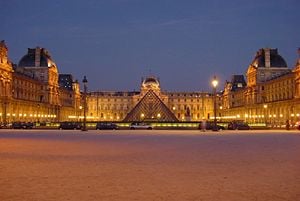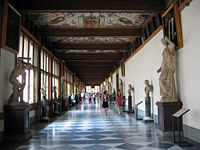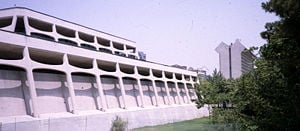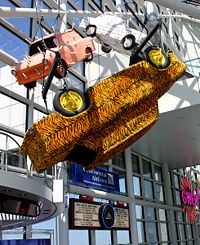Museum
A museum (from the Greek mouseion, which denotes a place or temple dedicated to the Muses) houses important historical artifacts for public viewing. Museums have a long history, dating back to Ancient Greece. Many early museums were private, established by wealthy individuals, and later made public. There are different types of museums all over the world, such as fine arts, applied arts, craft, archaeology, anthropology and ethnology, history, cultural history, military history, science, technology, children's museums, natural history, numismatics, botanical and zoological gardens, and philately. Many are famous landmarks, including the Louvre, in Paris, the British Museum, and the Gemäldegalerie Alte Meister Museum in Dresden, Germany. The purpose of a museum is to protect and conserve the different artifacts that represent human history throughout the world, for the sake of human knowledge, understanding, and enjoyment of the beauty and wisdom of those of different cultures.
Definition
The English museum comes from the Latin word, and is pluralized as "museums" (or, rarely, "musea"). It is originally from the Greek mouseion, which denotes a place or temple dedicated to the Muses (the patron divinities in Greek mythology of the arts), and hence a building set apart for study and the arts, especially the institute for philosophy and research at the Library established at Alexandria by the Ptolemies of Egypt in the early third century B.C.E. This was considered by many to be the first museum/library.
A museum is a "permanent institution in the service of society and of its development, open to the public, which acquires, conserves, researches, communicates and exhibits, for purposes of study, education, enjoyment, the tangible and intangible evidence of people and their environment."[1]
Museums enable people to explore collections for inspiration, learning, and enjoyment. They are institutions that collect, safeguard, and make accessible artifacts and specimens, which they hold in trust for society.[2]
History
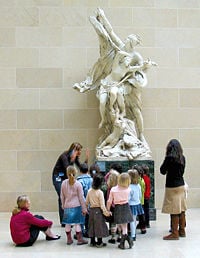
In ancient Greece a museum, originally a place connected with the Muses, sometimes in a religious sense but more usually as a place where the arts and learning were cultivated. Thus "museum" came to mean a place of education.
The most famous museum was that of Alexandria in Egypt, built near the royal palace about 280 B.C.E. by Ptolemy I Soter (ruled 323–283 B.C.E.). It was distinct from the Library, and housed scholars who were supported by the Ptolemies and, after Egypt came under Roman control, by the emperors. There is no evidence that there was provision for formal teaching, but lectures were given and there were many discussions which even the kings might attend; Cleopatra, the last independent ruler of Egypt, is reputed to have done so.
After the founding of Constantinople in 324 C.E. many of the museum scholars are said to have retreated there to avoid the theological controversies of Alexandria. The last member of the museum to be mentioned explicitly is Theon the mathematician, father of Hypatia, c. 400 C.E. Dinners with clever conversation were a characteristic institution of the museum; a poet of the third century B.C.E. described it as the "hen-coop of the Muses."[3]
Early museums began as the private collections of wealthy individuals, families, or institutions of art and rare or curious natural objects and artifacts. These were often displayed in so-called wonder rooms or cabinets of curiosities. Public access was often possible for the "respectable," especially to private art collections, but at the whim of the owner and his staff.
The first public museums in the world opened in Europe during the eighteenth century's Age of Enlightenment:
- The Museo Sacro, the first museum in the Vatican Museums complex, was opened in Rome in 1756
- The British Museum in London, was founded in 1753 and opened to the public in 1759. Sir Isaac Sloan's personal collection of curios provided the initial foundation for the British Museum's collection.
- The Uffizi Gallery in Florence, which had been open to visitors on request since the sixteenth century, was officially opened to the public in 1765.
- The Belvedere Palace of the Habsburg monarchs in Vienna opened with an outstanding collection of art in 1781.

These "public" museums, however, were often accessible only by the middle and upper classes. It could be difficult to gain entrance. In London, for example, prospective visitors to the British Museum had to apply in writing for admission. Even by 1800 it was possible to have to wait two weeks for an admission ticket. Visitors in small groups were limited to stays of two hours.
The first truly public museum was the Louvre in Paris, opened in 1793 during the French Revolution, enabling for the first time in history free access to the former French royal collections for people of all stations and status. The fabulous art treasures collected by the French monarchy over centuries were accessible to the public three days each décade (the ten-day unit which had replaced the week in the French Republican Calendar). The Conservatoire du Muséum National des Arts (National Museum of Arts' Conservatory) was charged with organizing the Louvre as a national public museum and the centerpiece of a planned national museum system. As Napoleon Bonaparte conquered the great cities of Europe, confiscating art objects as he went, the collections grew and the organizational task became more and more complicated. After Napoleon was defeated in 1815, many of the treasures he had amassed were gradually returned to their owners (and many were not). His plan was never fully realized, but his concept of a museum as an agent of nationalistic fervor had a profound influence throughout Europe.[4]
American museums eventually joined European museums as leading centers for the production of new knowledge in their fields of interest. A period of intense museum building, in both an intellectual and physical sense was realized in the late nineteenth and early twentieth centuries (called "The Museum Period" or "The Museum Age"). While many American museums, both natural history museums and art museums alike, were founded with the intention of focusing on the scientific discoveries and artistic developments in North America, many moved to emulate their European counterparts in certain ways (including the development of classical collections from ancient Egypt, Greece, Mesopotamia, and Rome). It is typically understood that universities took the place of museums as the centers for innovative research in the United States well before the start of the Second World War, however, museums to this day contribute new knowledge to their fields and continue to build collections that are useful for both research and display.
Purpose of Museums
Museums collect and care for objects of scientific, artistic, or historical importance and make them available for public viewing through exhibits that may be permanent or temporary. Large museums are located in major cities throughout the world and more local ones exist in small cities. Most museums offer programs and activities for a range of audiences, including adults, children, and families, as well as those for more specific professions. Programs for the public may consist of lectures or tutorials by the museum faculty or field experts, films, musical or dance performances, and technology demonstrations. Many times, museums concentrate on the host region's culture. Although most museums do not allow physical contact with the associated artifacts, there are some that are interactive and encourage a more hands-on approach.
Modern trends in museology have broadened the range of subject matter and introduced many interactive exhibits, which give the public the opportunity to make choices and engage in activities that may vary the experience from person to person. With the advent of the internet, there are growing numbers of virtual exhibits, web versions of exhibits showing images and playing recorded sound.[5]

The design of museums has evolved throughout history. Interpretive museums, as opposed to art museums, have missions reflecting curatorial guidance through the subject matter which now include content in the form of images, audio and visual effects, and interactive exhibits. Some of these experiences have very few or no artifacts; the National Constitution Center in Philadelphia, the Griffith Observatory in Los Angeles, being notable examples where there are few artifacts, but have strong, memorable stories to tell or information to interpret. In contrast, the United States Holocaust Memorial Museum in Washington, D.C. uses many artifacts in their memorable exhibitions.
Museums are usually open to the general public, sometimes charging an admission fee. Some museums have free entrance, either permanently or on special days, such as once per week or year. They are usually not run for the purpose of making a profit, unlike galleries which engage in the sale of objects. There are governmental museums, non-governmental, non-profit museums, and privately owned or family museums.
Museums function as houses that collect and exhibit culture. They are effectively cultural bookmarks, taking pieces of art, culture, history, and science and marking their glory in a location that the general public can view. Museums celebrate human culture and our ability to understand the world around us, such as in science history museums. At one point in time, museums aimed at a particular constituency. However with the rise of the information age and globalization, more diverse people are coming to see what is housed in museums. Many countries have museums celebrating not just human accomplishment, but the accomplishments and history of their own country as a form of nationalism.[6]
Museums and their upkeep are important because they are records of a timeline. Many artifacts in museums are extremely old and must be handled with utmost care or they will be damaged. Different types of museums celebrate different aspects of human culture. Many museums are now putting samples of their exhibits online in a virtual tour. This allows people to get a taste for what they are going to see before they actually arrive at the museum, helping them better plan what to see.
A museum normally houses a core collection of important selected objects in its field. Objects are formally accessioned by being registered in the museum's collection with an artifact number and details recorded about their provenance. The persons in charge of the collection and of the exhibits are known as curators.[4]
Museums are keepers of time. Walking through the halls of a museum is walking through the history of the human race. A visitor can get a small glimpse of how human beings have evolved and how humans have interacted with the world around them throughout time. Museums keep tabs on the evolution of humanity and the world around us, and objects that many look at as common today may be exhibits of museums in the future.
Management
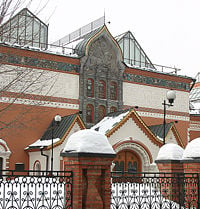
The museum is usually run by a director, who has a curatorial staff that cares for the objects and arranges their display. Large museums often will have a research division or institute, which are frequently involved with studies related to the museum's items, as well as an education department, in charge of providing interpretation of the materials to the general public. The director usually reports to a higher body, such as a governmental department or a board of trustees.
Objects come to the collection through a variety of means. Either the museum itself or an associated institute may organize expeditions to acquire more items or documentation for the museum. Museums may also purchase or trade for artifacts, or receive them as donations or bequests. Larger museums may have an "Acquisitions Department" whose staff is engaged fulltime in this activity. Most museums have a collections policy to help guide what is and is not included in the collection.
Museums often cooperate to sponsor joint, often traveling, exhibits on particular subjects when one museum may not by itself have a collection sufficiently large or important. These exhibits have limited engagements and often depend upon an additional entry fee from the public to cover costs.
Types of museums
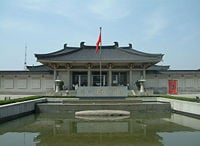
There are many types of museums, from very large collections in major cities, covering many of the categories below, to very small museums covering either a particular location in a general way, or a particular subject, such an individual notable person. Categories include: fine arts, applied arts, craft, archaeology, anthropology and ethnology, history, cultural history, military history, science, technology, children's museums, natural history, numismatics, botanical and zoological gardens, and philately. Within these categories many museums specialize further, such as museums of modern art, local history, aviation history, agriculture or geology.
History museums
History museums cover the knowledge of history and its relevance to the present and future. Some cover specialized aspects of history or a particular locality; others are more general. Such museums contain a wide range of objects, including documents, artifacts of all kinds, art, archaeological objects. Antiquities museums specialize in archaeological findings.
A common type of history museum is an historic house. An historic house may be a building of special architectural interest, the birthplace or home of a famous person, or a house with an interesting history.
Another type of history museum is a living museum, where people recreate a time period to the fullest extent, including buildings, clothes, and language. It is similar to historical reenactment.
Art museums
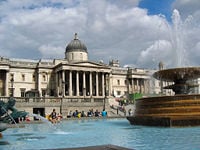
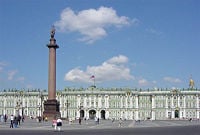
An art museum, also known as an art gallery, is a space for the exhibition of art, usually visual art, primarily paintings, illustrations, and sculpture. Collections of drawings and old master prints are often not displayed on the walls, but kept in a print room. There may be collections of applied art, including ceramics, metalwork, furniture, book art and other types of object.
The first publicly owned museum in Europe was the Uffizi Gallery in Florence. While initially conceived as a a palace for the offices of Florentian magistrates (hence the name), it later evolved into a display place for many of the paintings and sculpture collected by the Medici family or commissioned by them. After the house of Medici was extinguished, the art treasures remained in Florence, forming the first modern museums. The gallery had been open to visitors by request since the sixteenth century, and in 1765 it was officially opened to the public.
The specialized art museum is considered a fairly modern invention, the first being the Hermitage in St. Petersburg which was established in 1764.
The Louvre in Paris, France was established in 1793, soon after the French Revolution, when the royal treasures were declared for the people. The Czartoryski Museum in Kraków was established in 1796 by Princess Izabela Czartoryska. This showed the beginnings of removing art collections from the private domain of aristocracy and the wealthy into the public sphere, where they were seen as sites for educating the masses in taste and cultural refinement.
Science museums

Science museums and technology centers revolve around scientific marvels and their history. To explain complicated inventions, a combination of demonstrations, interactive programs and thought-provoking media are used. Some museums may have exhibits on topics such as computers, aviation, physics, astronomy, and the animal kingdom. Science museums, in particular, may consist of planetaria, or large theaters usually built around a dome. Museums may have IMAX feature films, which may provide 3D viewing or higher quality picture. As a result, IMAX content provides a more immersive experience for people of all ages.
Natural history museums
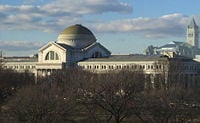
Museums of natural history and natural science typically exhibit work of the natural world. The focus lies on nature and culture. Exhibitions may educate the masses about dinosaurs, ancient history, and anthropology. Evolution, environmental issues, and biodiversity are major areas in natural science museums. Notable museums of this type include the Natural History Museum in London, the Oxford University Museum of Natural History in Oxford, the Muséum national d'histoire naturelle in Paris, the Smithsonian Institution's National Museum of Natural History in Washington, D.C., the American Museum of Natural History in New York City, the Royal Tyrrell Museum of Palaeontology in Drumheller, Alberta, and the Field Museum of Natural History in Chicago.
Zoos and Zoological Gardens
Although zoos are not often thought of as museums, they may be considered "living museums." They exist for the same purpose as other museums: to educate, inspire action, study, and preserve a collection. Notable zoos include the Wildlife Conservation Society Zoos in New York, London Zoo, the San Diego Zoo, Berlin Zoo, Taronga Zoo in Sydney, Australia, Frankfurt Zoo and Zoo Zurich in Switzerland.
Open air museums
Open air museums collect and re-erect old buildings at large outdoor sites, usually in settings of re-created landscapes of the past. The first one was King Oscar II's collection near Oslo, Norway, opened in 1881. In 1891 Arthur Hazelius founded the famous Skansen in Stockholm, which became the model for subsequent open air museums in Northern and Eastern Europe, and eventually in other parts of the world. Most open air museums are located in regions where wooden architecture prevailed, as wooden structures may be translocated without substantial loss of authenticity. A more recent but related idea is realized in ecomuseums, which originated in France.
Other museums
A number of different museums exist to demonstrate a variety of topics. Music museums may celebrate the life and work of composer or musicians, such as the Rock and Roll Hall of Fame in Cleveland, Ohio. Other music museums include live music recitals such as the Handel House Museum in London.
A recent development with the expansion of the internet is the establishment of virtual museums, typically with no counterpart in the real world. Examples of these might be the LIMAC, which has no physical location, as well as online curatorial platforms such as Rhizome.
Museums targeted for the youth, such as the Miami Children's Museum, often exhibit interactive and educational material on a wide array of topics. The Baseball Hall of Fame museum is an institution of the sports category. The Corning Museum of Glass is devoted to the art, history, and science of glass. Interpretation centers are modern museums or visitors centers that often uses new means of communication with the public.
Mobile museums
Mobile museum is a term applied to museums that make exhibitions from a vehicle, such as a van. Some institutions, such as St. Vital Historical Society and the Walker Art Center, use the term to refer to a portion of their collection that travels to sites away from the museum for educational purposes. Other mobile museums have no "home site," and use travel as their exclusive means of presentation.
List of Famous Museums
Below is a short list of notable museums worldwide:
- The Bahrain National Museum collects the artistic, natural, and physical history of Bahrain and its people.
- British Museum – The British Museum in London, England is one of the world's largest museums of human history and culture.
- The Egyptian Museum in Cairo, Egypt was established in 1835 and contains over 120,000 historical objects, dating back from the pre-historic era.
- The Gemäldegalerie Alte Meister, in Dresden, Germany is known for its art history, music, and literature collections.
- Guggenheim Museum – the Guggenheim Museum in New York City, United States seeks to promote appreciation and understanding of contemporary art and artists.
- Louvre – the Louvre in Paris, France was established in 1793 and has as its principle responsibility the conservation, protection, restoration, and development of France's national art treasures.
- The National Museum in New Delhi, India has over 200,000 pieces of art that cover more than five thousand years of cultural Indian heritage.
- Shanghai Museum of Art and History – the Museum of Art and History in Shanghai, China houses many artistic treasures from ancient dynasties.
- Smithsonian Institution – the Smithsonian Institution in Washington, D.C., United States, opened in 1846 and seeks to provide knowledge to the public.
- The South African Museum in Cape Town, South Africa is a science museum that houses more than one and a half million scientific specimens for study and public observation.
- The Swedish Museum of Natural History in Stockholm, Sweden attempts to show the public the delicate balance of nature and environment through a holistic perspective.
- Tate Gallery – the Tate Gallery in London, England, seeks to increase peoples knowledge and appreciation of British art from the sixteenth century to the modern era.
- The Tokugawa Art Museum in Nagoya, Japan is an historical museum renowned for its artifacts from the twelfth century.
Notes
- ↑ Statutes International Council of Museums. Retrieved June 23, 2007.
- ↑ The Museums Association. What is a Museum? (1998). Retrieved June 14, 2007.
- ↑ “Museum,” in The Concise Oxford Companion to Classical Literature (Oxford University Press, 2003). Available online from Answers.com. Retrieved August 20, 2007.
- ↑ 4.0 4.1 Mettina Bessias Carbonell, Museum Studies: An Anthology of Contexts (Blackwell Publishing Limited, 2003, ISBN 978-0631228301).
- ↑ Ivan Karp, et. al., Museum Frictions: Public Cultures/Global Transformations (Durham, NC: Duke University Press, 2006, ISBN 978-0822338949).
- ↑ Ivan Karp, et. al., Museums and Communities (Smithsonian, 1992, ISBN 156098189X).
ReferencesISBN links support NWE through referral fees
- Anderson, Gail. Reinventing the Museum, Historical and Contemporary Perspectives on the Paradigm Shift. AltaMira Press, 2004. ISBN 0759101701
- Bennett, Tony. The Birth of the Museum: History, Theory, Politics. Routledge, 1995. ISBN 978-0415053877
- Carbonell, Bettina Messias (ed.). Museum Studies: An Anthology of Contexts. Blackwell Publishing, 2003. ISBN 0631228306
- Hooper-Greenhill, Eilean. Museums and the Interpretation of Visual Culture. Routledge, 2000. ISBN 0415086337
- Karp, Ivan, Christine Mullen Kreamer, and Steven Levine (eds.). Museums and Communities. Smithsonian Books, 1992. ISBN 156098189X
- Karp, Ivan, Connie A. Kratz, Lynn Szwaja, and Tomas Ybarra-Frausto (eds.). Museum Frictions: Public Cultures/Global Transformations. Durham, NC: Duke University Press Books, 2006. ISBN 978-0822338949
External links
All links retrieved November 10, 2022.
- International Council of Museums
- American Alliance of Museums
- Museot - Finnish Museums
- Canadian Museums Association
- Museums in Russia
Credits
New World Encyclopedia writers and editors rewrote and completed the Wikipedia article in accordance with New World Encyclopedia standards. This article abides by terms of the Creative Commons CC-by-sa 3.0 License (CC-by-sa), which may be used and disseminated with proper attribution. Credit is due under the terms of this license that can reference both the New World Encyclopedia contributors and the selfless volunteer contributors of the Wikimedia Foundation. To cite this article click here for a list of acceptable citing formats.The history of earlier contributions by wikipedians is accessible to researchers here:
The history of this article since it was imported to New World Encyclopedia:
Note: Some restrictions may apply to use of individual images which are separately licensed.
